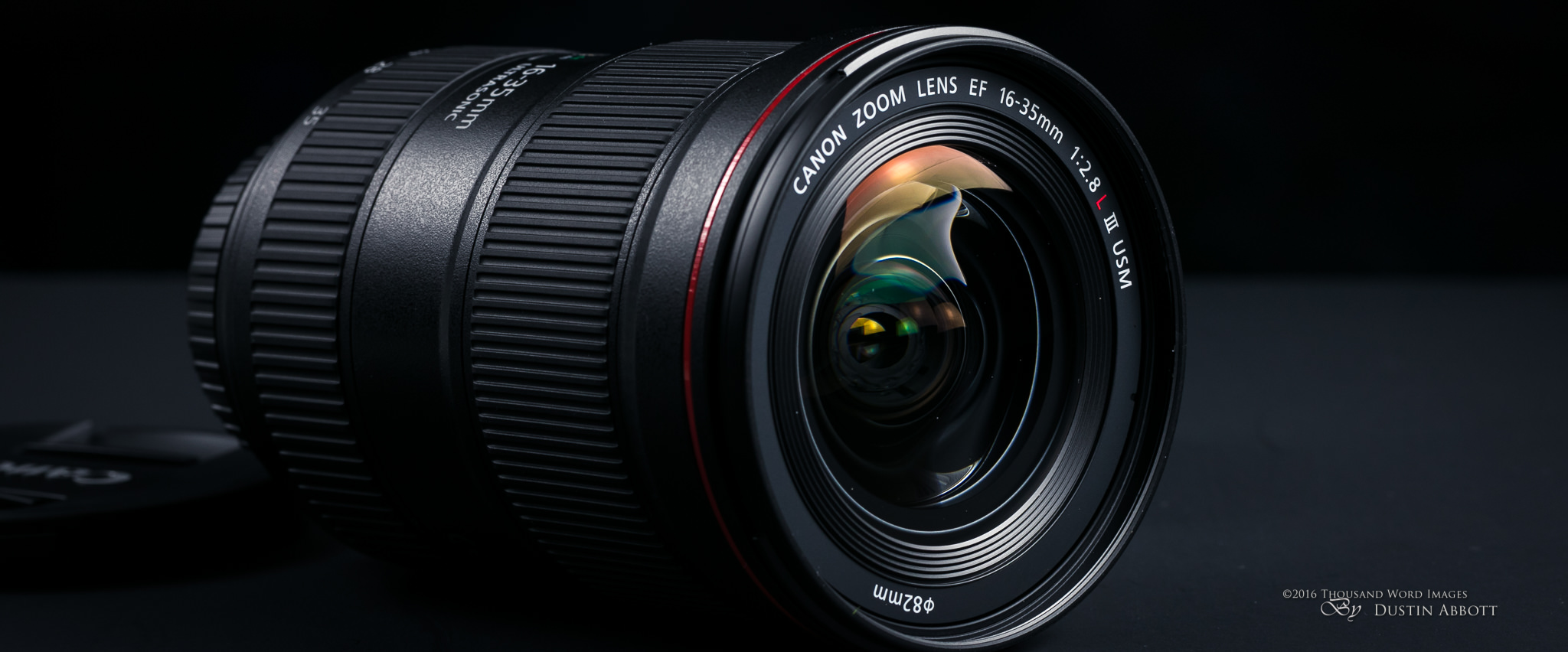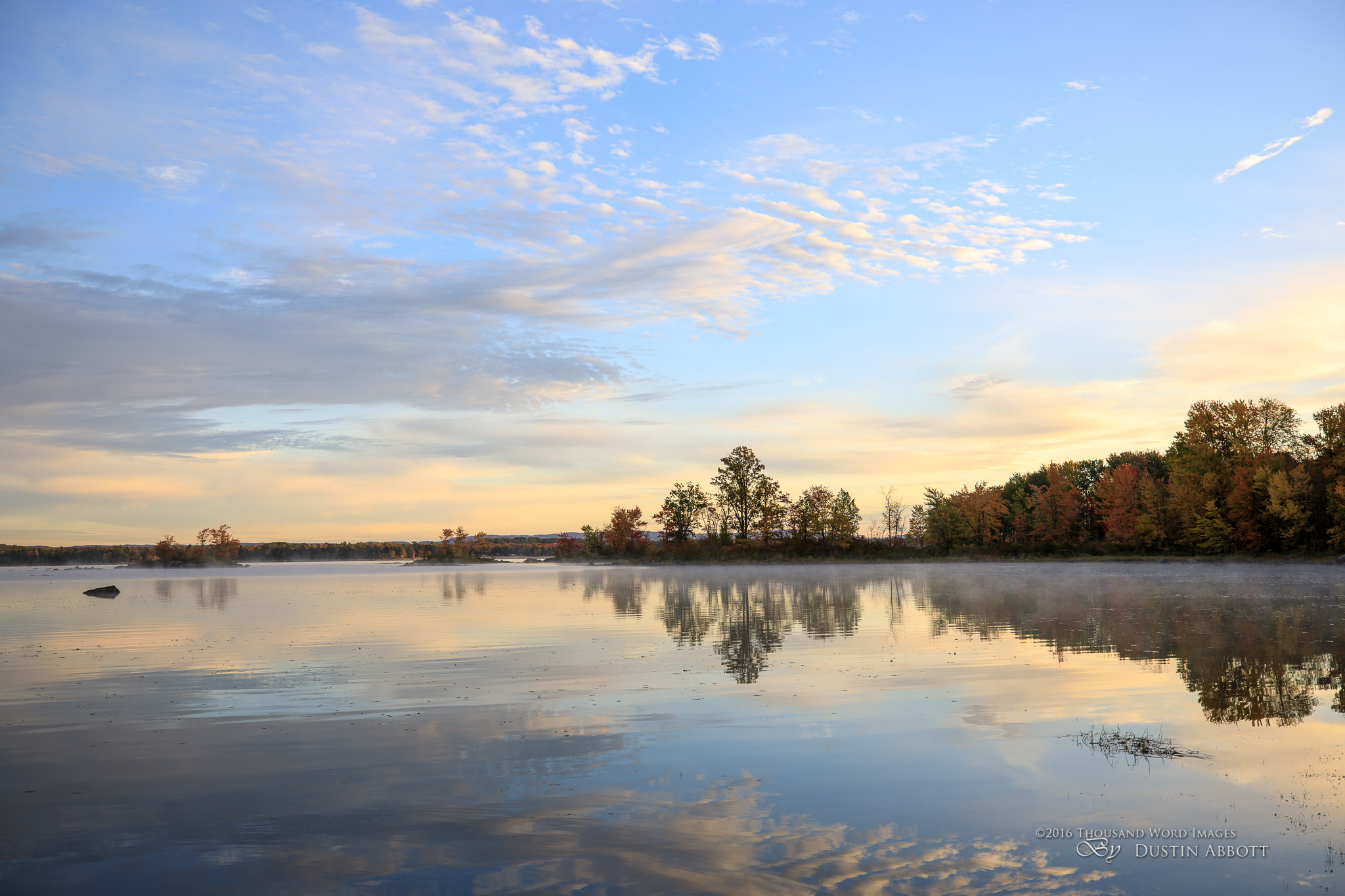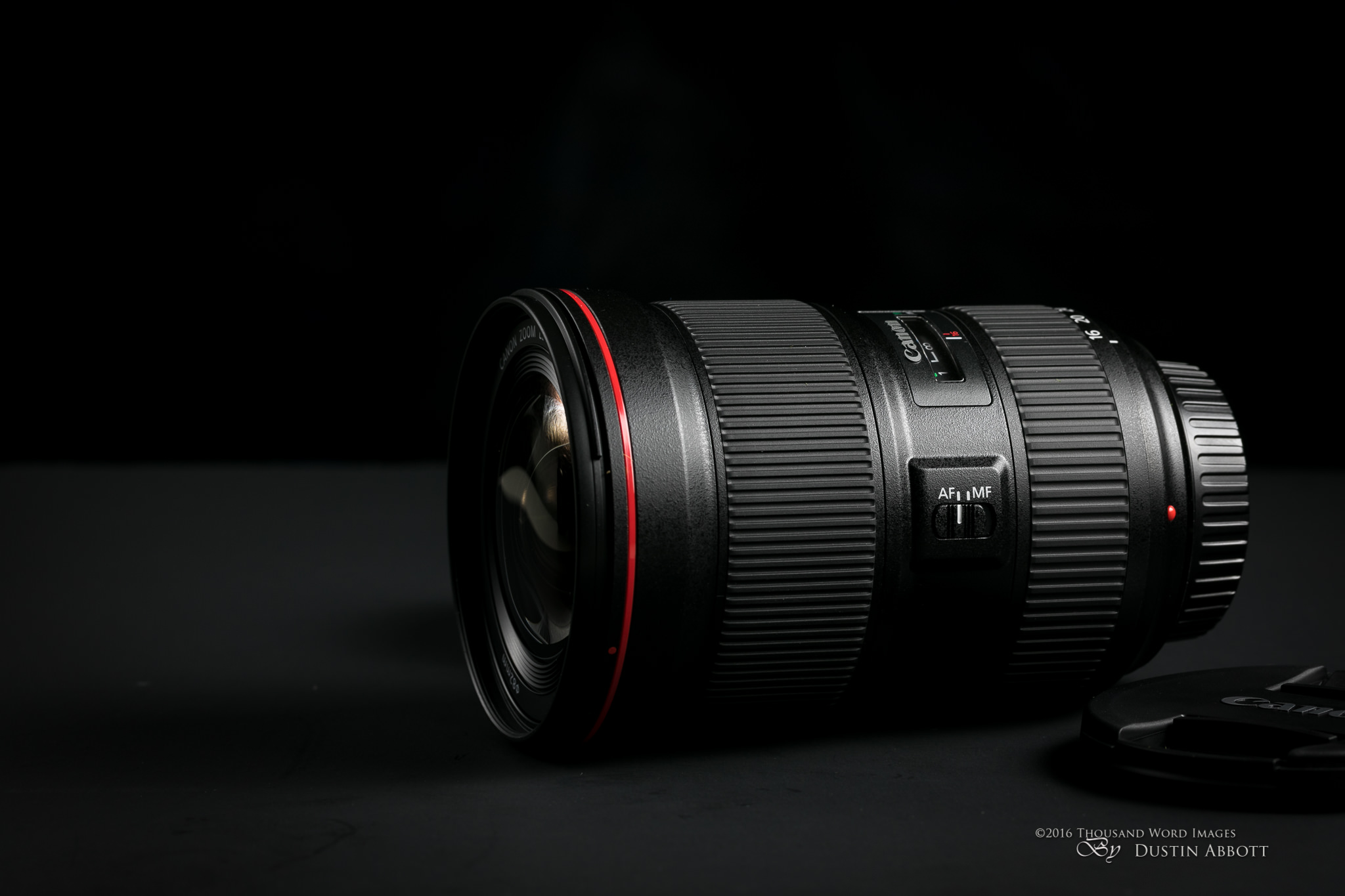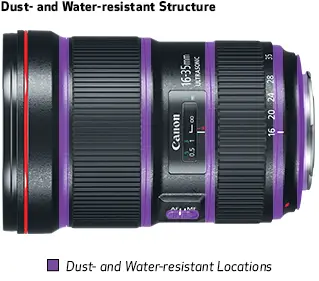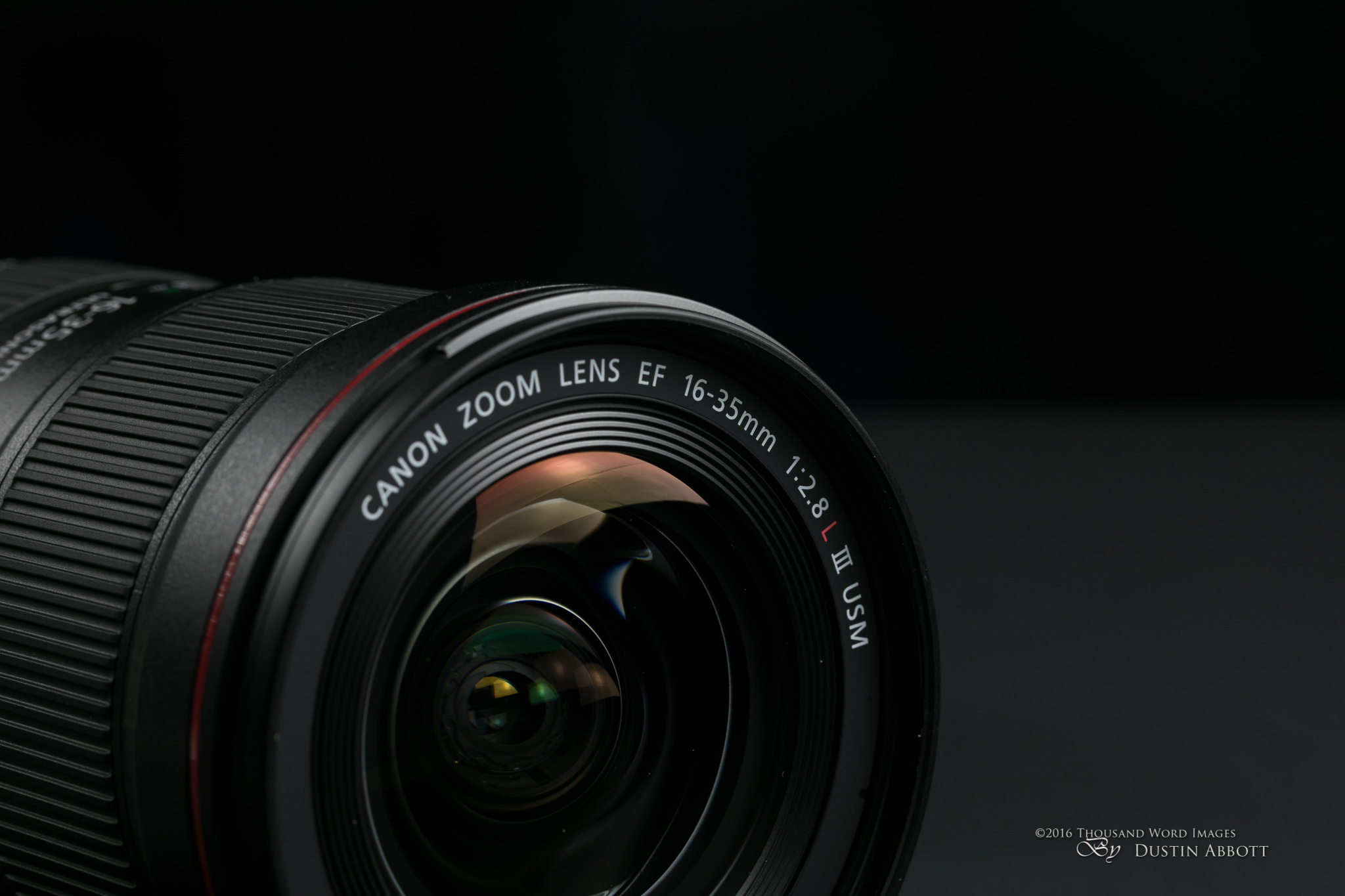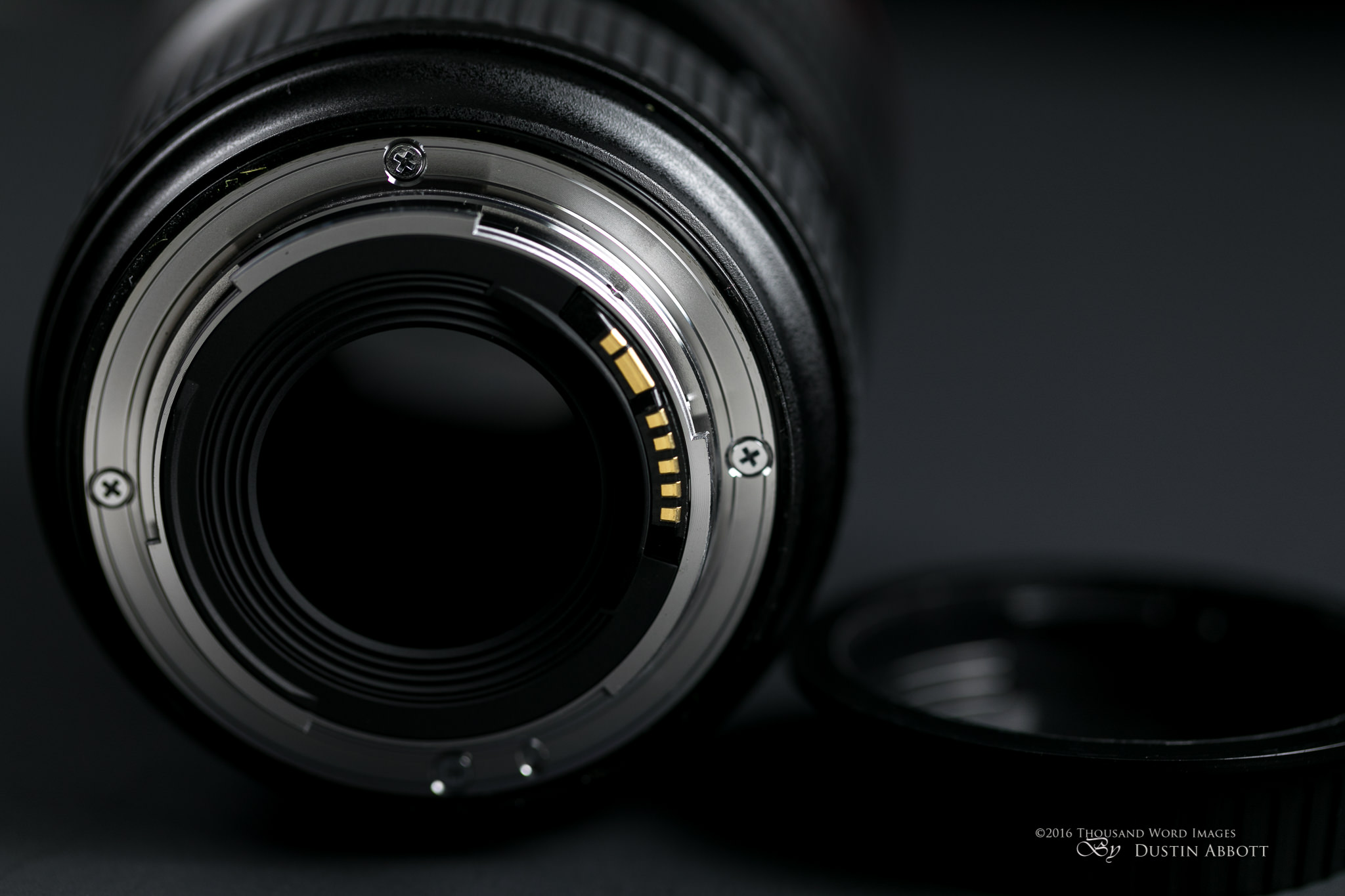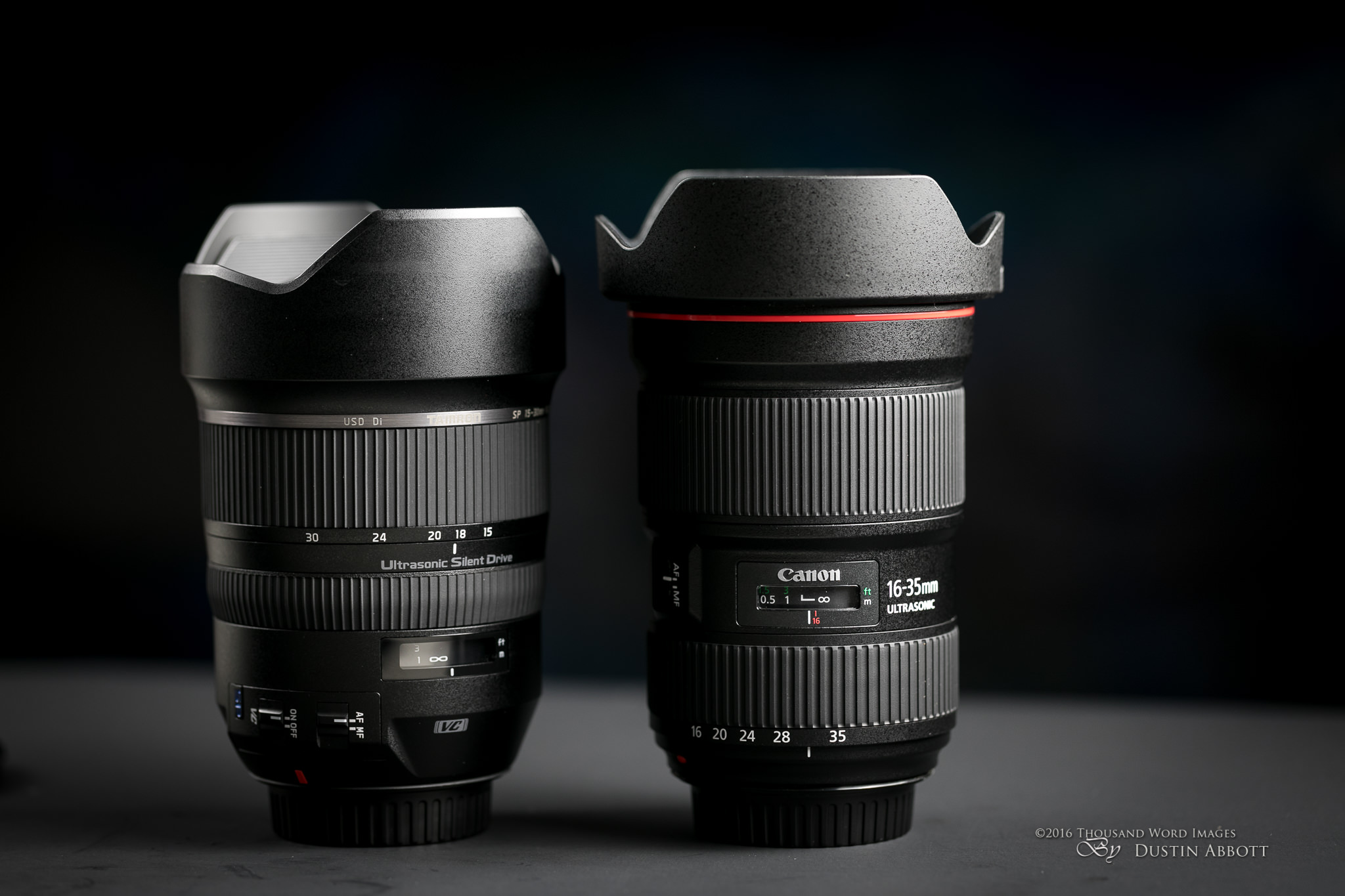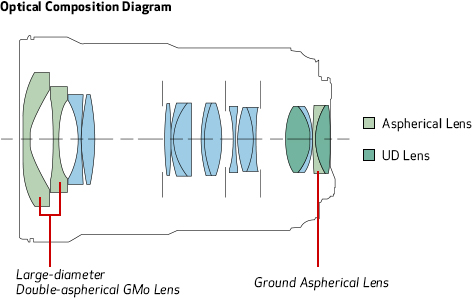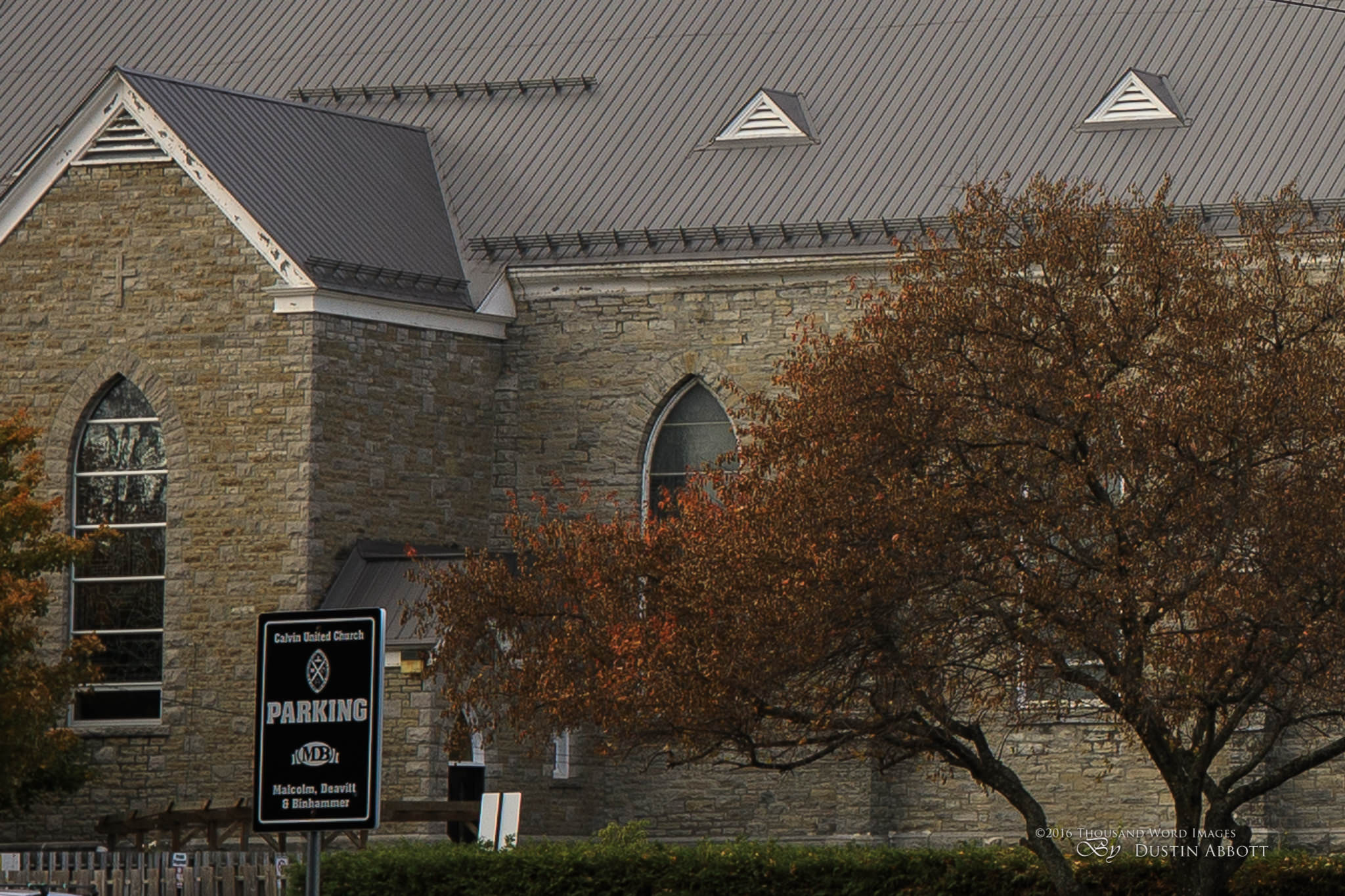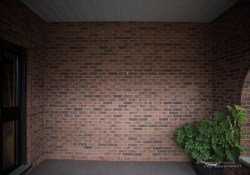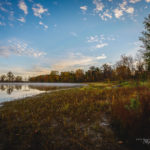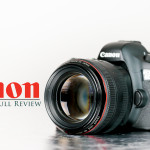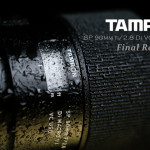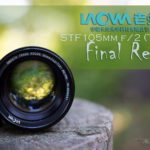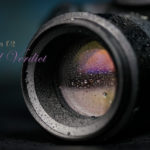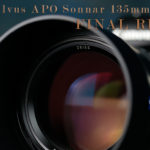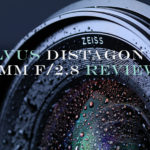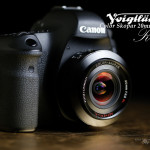Okay. Raise your hand if you wanted/expected this lens to come with an image stabilizer? In a day when many people use DSLRs as hybrid stills/video cameras and when Canon offers camera bodies with 30 and 50 megapixels, one would think that adding IS would have been a priority, but Canon has elected otherwise. Tamron proved a few years ago that such a lens is possible with its 15-30mm f/2.8 VC, but it will continue as the lone option for Canon shooters that want both the large f/2.8 maximum aperture and an image stabilizer in a wide angle zoom. Take a deep breath if this was your main priority, wipe away that tear from the corner of your eye, and let’s move on. The Canon EF 16-35mm f/2.8L III USM is not the lens where Canon marries a wide aperture with an image stabilizer, but the 16-35L III is the lens where Canon gets most of the ingredients right for building an exceptional wide angle zoom.
A few years ago Canon shooters were out in the cold when it came to wide angle zoom lenses. It was the one area where Canon glass wasn’t the best. But things started to turn around with the release of the excellent Canon EF 16-35mm f/4L IS, a lens that has been both critically and commercially successful. It was one of those rare moments when Canon released something that was both excellent and fairly priced. Canon followed that up with the far more specialist 11-24mm f/4L, a lens with a truly extreme focal length. While not without faults, the 11-24L is a unique lens that is very good at what it does. But the final frontier for Canon was taking that newfound optical performance into their flagship f/2.8 zoom. After spending time with the lens, it’s clear that Canon has successfully done so, though there is just enough ambiguity left for ongoing debate.
Prefer to watch your reviews? Click the videos below!
Check me out on: Google+: | Facebook: | Twitter: | Flickr: | 500px: | Sign Up for My Newsletter :
Build and Handling
If you are familiar with the 16-35mm f/4L IS, then you have a fairly good idea about the general shape of the 16-35L III. It has a similar overall look, though with a slightly longer barrel and more of a flare out to the larger 82mm front filter thread. The 16-35L III is a little over a half inch longer (5.02”/127.5mm vs 4.44”/112.8mm) and it has put on some weight (27.87oz/790g vs 21.6oz/615g) over the f/4 version as well as the 16-35 Mark II (22.4oz/635g). This lens is now on the larger size of medium, and those that are serious backpackers or travelers won’t be happy to see the weight gain. That’s basically a 20% weight gain over the previous lens, so if you are a backpacker you may want to stick with the f/4 version.
The lens feels very well made in the Canon L way, and literature from Canon shows that the weather sealing has ramped up with a number of new internal seals. They say, “It features a dust- and water-resistant construction on the switch panel, the zoom and focus rings, and on the lens mount, helping to prevent dust and moisture from interfering with operation. When outfitted with a Canon filter, the EF 16–35mm f/2.8L III USM is supremely dust- and water-resistant.” ‘Supremely’ is a very confident word to apply to dust and water resistance. This diagram shows the various points that seals have been built into the lens.
Note that Canon does recommend the use of a front filter to “seal the deal”. If you choose to forego that filter, however, the lens has expensive fluorine coatings on both the front and rear elements. The nicest thing about the fluorine coating is that it makes them much easier to clean as finger prints and oils don’t bond to the fluorine.
On this note this is both some internal movement of the front element when zooming (always within the limits of the outer barrel) and when zoomed to 35mm there is a pretty huge gap created at the back of the lens where I can see inside the lens. Not unusual, but for your information…
The body is primarily engineered plastics (high grade) around a metal core. The lens feels hefty but without that unique density of a Zeiss lens and its all metal construction. The front filter threads are plastic and are in a 82mm size, which is on the large size of normal but still within the scope of easily accessible and not overly exorbitant in price. I’ve been using a Fotodiox Pro WonderPana filter system for the Tamron 15-30 VC but such a system is a bit expensive and definitely more clunky that just being able to screw on traditional filters. The continued ability to use screw in filters is a big plus here over alternatives with a protruding front element.
Both the zoom ring (closest to the barrel) and the manual focus ring (near the front of the lens) move easily. Full time manual override is available at any point, but be aware that the focus throw is really short (only about 90 degrees), so precision manual focus is a bit challenging.
For you video shooters: focus stays pretty consistent when zooming the lens and the lens doesn’t really seems to focus breathe, so you won’t have to worry the size of objects significantly changing.
There is one switch on the barrel (AF/MF) and a distant window, but no real hyperfocal markings. This isn’t a lens designed around the concept of manual focusing. Good thing its autofocus is exceptional!
Canon has also changed the coatings on this lens. They say this, “The EF 16–35mm f/2.8L III USM features both Subwavelength Coatings (SWC) and Air Sphere Coatings (ASC) on its lens elements to help combat reflections, flare and ghosting, and deliver clean images with reduced aberrations from reflected light. Subwavelength Coatings help prevent reflections by arranging an array of wedge-shaped nanostructures on the lens’s surface that are smaller than the wavelength of visible light and are able to help control reflection and flare. Air Sphere Coating technology puts an ultra-low refractive layer on the lens element designed to significantly reduce both flare and ghosting. These coatings, in concert with the EF 16–35mm f/2.8L III USM’s overall optical formula, help to deliver a clean image to the camera’s sensor, which can decrease the need for post-production.”
This is a solid, nicely made lens. It is smaller than the Tamron 15-30, but not as much as what I anticipated. The Canon is a bit shorter without the lens hood (the Tamron’s hood is permanently integrated), but with the hoods in place the 16-35L III is actually a bit longer. The 16-35L III has noticeably less girth (and weighs less to prove it), but functionally there isn’t much of a difference between these lenses in size. At the same time the lens feels good mounted on a camera. On a full frame body (where it will mostly be used by consumers) it feels nicely balanced.
Autofocus = Just Right
In my experience it is rare for Canon to get autofocus wrong on its lenses, and I certainly was not disappointed with the 16-35L III. Autofocus is very fast, accurate, and I had zero drama during calibration. Canon’s true ring type USM motors are pretty much the best out there, and truthfully it is in this department where the first party lenses have their greatest advantage. In many cases the third party lenses from Sigma, Tamron, Zeiss, and even Samyang/Rokinon offer up just as good (if not better) image quality, but no one does autofocus quite as well as Canon and Nikon. Part of this is because third party lenses (those with autofocus) often have to reverse engineer autofocus algorithms (Canon and Nikon won’t license the technology to them), which means that they don’t always have access to cutting edge tech and sometimes develop quirks when new camera bodies are released. I had this happen to the Tamron 15-30mm f/2.8 VC I’ve been shooting with when the 5D Mark IV came out. It didn’t function right in Live View mode, and Live View would “crash” or instantly shut down with the lens attached. I had to send it to Tamron and have the firmware updated to fix this issue.
Both Sigma and Tamron have developed a workaround to this by offering their USB Dock and Tamron Tap In Console that allow firmware updates (along with other tweaks) to be directly delivered to consumers without the need for their lenses to be sent in for updating. This only works for the newer lenses that are compatible with these devices. But there is no such hassle with first party lenses. They just work…and this is a serious consideration when choosing a lens.
I’ve found autofocus accuracy to be very good with the lens, though, to be fair, there is less pressure on wide angle lenses than telephoto lenses as the depth of field is much larger (there is larger room for error). The 16-35L III will focus well in all situations, though, and it is one of the reasons that a lens like this is so valuable to photojournalists and wedding photographers. You need a lens you can rely on in those types of situations. I have no question that the 16-35L III is going to deliver consistent, repeatable autofocus results. This wide open JPEG shows how the lens nailed focus on my desired target.
I did a repeatability test by setting up a fixed target with good contrast, putting the camera (5D Mark IV) on a tripod with 2 second delay (to eliminate vibration). I defocused the lens between shots and autofocused (traditional Phase Detect/Viewfinder AF) and hit the shutter as soon as the “beep” confirmed autofocus. I shot at an f/2.8 aperture and 35mm to put the most stress on the AF system possible. I repeated the test ten times. I then cropped the images in post so that basically only the target is showing. As you move throughout the ten frames you have essentially the same shot every time with very little shifts and movements. Focus is perfect each time. This is exactly what you want: repeatability.
Just for comparison sake, I shot the same test with the Tamron 15-30 at f/2.8 and 30mm. The results were largely the same, save one shot showed a slight miss. I’ve been happy with the Tamron’s focus (and as I said, the demands are somewhat low on a wide angle lens), but I’d without question give the autofocus edge to the first party lens.
Autofocus speed for either lens is very fast (I couldn’t discern a difference), and they both make very little sound when autofocusing (you can hear a very slight “schhhhtk” as the elements align.) This is a definite strength for the lens.
Image Quality
If you are interested in optical designs, here’s an interesting bit of trivia. All three of Canon’s most recent 16-35mm zooms have 16 elements, but where the f/4 version and MK II have those elements in 12 groups, the new 16-35L III actually has only 11 groups. But there is no question the optics have been optimized.
When the lens was announced and the MTF charts were released it became clear that the 16-35L III would be a vast improvement over the MKII version of the lens. At wide apertures the MKII was not overly impressive. The center of the frame wasn’t bad, but the corners were soft. More important was the reality that the corners of the frame never really got perfectly sharp even when the lens was stopped down to smaller apertures. It was prone to chromatic aberrations, had a fairly strong amount of distortion, and vignetted quite heavily. I hadn’t used one (had the 17-40L instead) until I brought one in to compare to the 16-35 f/4L IS when it came out. I shot head to head images and was pretty shocked by how bad the images from the MKII looked by comparison. The 16-35 f/4L was a dramatically improved lens, and the 16-35L II suffered by comparison in that three way shootout series (including the Tamron, which was new at the time as well).
The 16-35L III has addressed many of the flaws of the previous lens. It is much, much sharper, and manages to [slightly] best the excellent 16-35 f/4 with both lenses at their maximum apertures (f/4 vs f/2.8). This is impressive in and of itself, and, while I don’t have the 16-35 f/4 on hand, I do have the Tamron to compare it with. This is arguably a more apples to apples comparison as both share the same maximum aperture. The Canon is sharper in the center, though at wide apertures (and with the copy of each lens that I have) I’m actually finding a bit of an advantage for the Tamron in the corners in some situations. This wide open image of a church along the pixel level crop shows how much detail is being resolved by the lens.
In field work the 16-35L III is delivering consistently crisp results. I tend to shoot a lot of forest scenes (particularly during autumn), and the Canon is having no problem resolving all of the little details of the leaves and textures one finds in the forest. I’ve added a lot of very impressive results to my catalog.
Other strengths include excellent contrast (no more slightly hazy textures), very strong flare resistance (a notable advantage over the Tamron and its curved front element), and a vast, vast improvement of chromatic aberration control. An area of weakness for the previous lens has turned to an area of strength. It is worth noting too that the lens produces one of the nicest sunstars/sunbursts of any lens I’ve seen. Very long, well defined points that add a lot of style to images. A little detail, perhaps, but one that can help make a good image great.
The lens has a similar minimum focus distance spec to the previous generation (11.02”/28cm), but delivers a stronger maximum magnification figure of 0.25x (0.22x for the Mark II). A bit closer to a true 35mm, perhaps? The Tamron shares the minimum focus distance, but its shorter maximum focal length (30mm) results in a less dramatic magnification (it only manages .20x).
There’s no question that the 16-35L III’s 1:4 magnification is a useful figure, and it makes for some great storytelling images. One of the few strengths that I perceived for the 16-35L II in my three way shootout was that it had very nice bokeh. In fact, it was shockingly good for a wide angle lens. I think that the 16-35L III shares that quality, which is impressive considering how much sharper it is. Look at how nice the bokeh highlights are in this iamge:
Shorter focal lengths like this mean that there are few situations where you can really throw a background out of focus, but at least when you are in those situations this lens will do a great job of delivering nice defocused areas.
But the story isn’t all rosy on the optical view front. The lens has two optical weaknesses; one big, one moderate. The big one is that the lens has actually regressed in the area of vignette. It delivers one of the poorest results that I have seen, with extreme corner shading passing FOUR stops…ouch! Having early access to the lens means that I am using it before there is a standard corrective profile in Adobe Lightroom/ACR, and so I’ve seen the lens without any digital trickery to hide its flaws. This is actually an area of strength for the Tamron, which has essentially half the vignette of the 16-35L III. There are few examples here below, and the difference between the Canon and Tamron images wide open (Canon images are first in the series) is pretty startling.
Ironically my head to head comparison revealed that if I zoomed to a pixel level in the middle of the frame (eliminating the vignette) the 16-35L III actually had a brighter image (better light transmission), but when the viewing the images globally the Tamron image actually seemed much brighter because the Canon’s vignette penetrates so deeply into the frame.
I ran a comparison through Canon’s DPP software (which did have a profile available), and did a direct comparison to the Tamron. After correcting for distortion and vignette for both lenses I found that the vignette was heavy enough that full profile correction resulted in some visible noise in the edges that the Tamron doesn’t show… and that was on the 5D Mark IV, which is excellent at lifting shadows. Other bodies may deliver a poorer result. This will be an even bigger issue for video shooters for obvious reasons. Look at the noise levels after correction in the comparison below:
The second issue is that the lens has quite a bit of distortion on the wide end of the focal length. While that is not necessarily unusual (and there is a slight bit of improvement over the previous generation of the lens), you still need to be careful at the angle you hold the camera at as you can create some destructive stretching of the image along the edges of the frame if you’re notecareful. This isn’t unique to this lens, of course, but is something you have to be aware of with most wide angle lenses. The Zeiss Milvus 18mm that I just reviewed felt like it exhibited much less field distortion, though, to be fair, 18mm is a less extreme focal length. Watch for putting people too close to the edge of the frame at the wider focal lengths on this lens; no one will thank you for stretching them out!
The list of optical negatives is pretty short. This is one of the best wide angle zoom lenses available and its performance exceeds that of most wide angle primes, too. Space prevents me sharing too many images in the review, so I recommend you visit the Image Gallery from this lens here to see more of what I’ve gotten during my review period.
Coma
Coma performance is a key issue for wide angle lenses. This is from Wikipedia: “In optics (especially telescopes), the coma, or comatic aberration, in an optical system refers to aberration inherent to certain optical designs or due to imperfection in the lens or other components that results in off-axis point sources such as stars appearing distorted, appearing to have a tail (coma) like a comet.” This is a pretty huge consideration for a lens like this. This is an area I felt the Canon EF 16-35mm f/4L IS fell short. A poor coma performance results in a night sky that looks distorted along the edges and lacks crisp definition in the stars. The previous version of this lens was not a particularly great astrophotography lens.
My favorite Zeiss to date for astrophotography has been the Distagon 15mm along with the Tamron 15-30 VC. The Zeiss Milvus 18mm I just reviewed was another very good astrophotography lens. There is some very good news on this front: the new 16-35L III exhibits very low coma. This isn’t to say that it is entirely free from coma; in the corners there are a few star points that become a little more wedge shaped. This is still a better performance than most, however, and the best I’ve seen out of the Canon wide angle zoom lenses.
I see only one issue that will negatively impact astrophotography use, and that is the heavy vignette already mentioned. This is correctable, obviously, but astrophotography is also often done at higher ISO settings so there is some risk of introducing noise or color banding in that correction.
Not a Slam Dunk
I went into this review with the full expectation that this would be the lens that would make me take a long look at the Tamron 15-30 VC (the lens I’ve been using for wide angle work) and potentially move it for this lens. For one thing, the Tamron is a big, heavy lens. I even said in my introductory video that I was excited over the potential to have a very sharp lens with that maximum f/2.8 aperture in a smaller package than the Tamron. And, to be fair, the 16-35L III is lighter (790g vs 1100) and narrower around (the Tamron is about 12mm thicker in girth), but the Canon isn’t much shorter than the Tamron, and, with the hood in place, is actually a bit longer. It won’t really take up much less space in your bag, and it definitely has gained weight (and a bit of size) when compared with the 16-35 f/4L.
If I were to just pick a lens, I would probably pick the 16-35L III, though I like the slightly wider focal length, the image stabilizer, and very low vignette of the Tamron a lot. It has treated me very well, and produced images that have paid for itself several times over. The Canon uses traditional filters (some savings there), is less flare prone, and delivers slightly better image quality (though there is some give and take across the frame). But the Canon also costs a thousand dollars more, which in this case makes it almost twice as expensive. I would be willing to pay that if the lens were a slam dunk over the Tamron, but I’m not sure that’s the case for me.
If you would like to see a comparison of the pros and cons for each lens, watch this video:
Conclusion:
It feels strange to once again feel somewhat ambiguous after spending time with such an excellent lens. I was really excited for its arrival, got excellent results with it, but find myself still somewhat divided about the lens. I felt the same after my time with the Zeiss Milvus 18mm f/2.8, or the Sigma 20mm f/1.4 ART. The Canon EF 16-35mm f/2.8L III USM is the kind of lens that Canon was incapable of producing five years ago – a wide angle lens that is optically exceptional even at f/2.8. I love the crisp results that I’m getting. Canon has improved on the 16-35L II in almost every way. Chromatic aberrations are very well controlled (a welcome relief after the 16-35L II), and gone is the haziness at f/2.8. The lens is highly flare resistant, produces beautiful sun bursts/sun stars, and has a very useful 0.25x maximum magnification (pretty much class leading). It has strong contrast and is incredibly sharp. The 16-35L III is capable of producing stunning results and is well deserving for consideration for wedding photographers, photojournalists, and landscape photographers. This is one of the best wide angle zooms ever made. So why am I ambiguous?
Because this lens doesn’t exist in a vacuum.
Canon has basically two threats to this lens: 1) the high cost of entry and 2) the strong performance of its rivals. As I said in the Milvus 18mm review, the very high price tag gives a higher burden of expectation and makes me more critical of serious faults. I’ve not really mentioned the number of excellent manual focus prime alternatives from the smaller third party players (Samyang, Laowa, Irix) or even the new Sigma 12-24mm ART lens. Five years ago there were very few decent wide angle choices. Today there are a lot of them.
There’s only one significant fault with the Canon EF 16-35mm f/2.8L III. That heavy vignette holds the lens back at wide apertures. It has basically twice as much vignette at f/2.8 as the Tamron 15-30 VC. It is fortunate that this is a first party lens and thus gets all of the correction tools in camera that will save JPEGs, as without that correction I’m disappointed by the results for events despite the great sharpness. A heavy vignette is more acceptable in a portrait lens where a vignette can create a unique look, but that’s rarely the case with a wide angle lens. The vignette is heavy enough that correcting for it in post does increase noise levels along the outer portions of the image circle. I’m also not crazy about the distortion, but to be fair it is improved over the previous generation. Am I expecting too much? Perhaps, but slapping a big price tag on a lens increases my expectations of its performance.
So we’ve got a lens that costs $2199 in the US and more elsewhere (It is $2849 + 13% tax here in Canada), and that is going to cause a lot of potential buyers to pause and consider the alternatives. For those that mostly shoot landscapes, Canon’s own 16-35mm f/4L IS is just about as sharp, lighter, and half the price (or even less). Then there is the Tamron 15-30mm f/2.8 VC, which has a slightly wider perspective plus the faster aperture…and adds an image stabilizer…for half the price.
Canon has left photographers with an either/or choice. You can have a reasonably priced, optically excellent lens with an image stabilizer but a maximum aperture of only f/4 (the excellent Canon EF 16-35 f/4L IS) or you can have an expensive, optically excellent lens with the desirable maximum aperture of f/2.8 for event, low light, or astrophotography work…but you can’t have both the wide aperture and the image stabilizer. The problem is that a lot of photographers wanted this lens to have both, and the price point of $2199 seems more in line with a lens that does have both. As I reviewed the catalog of images I got with the lens I questioned if there were any that I couldn’t have gotten with either the Tamron or the f/4L IS.
In many ways the 16-35L III is the better lens (it is definitely more polished than the Tamron), but the definitive question is, “Is it worth twice as much?” To those that shun third party lenses, need f/2.8, and want the absolute best, the answer is definitely yes, but to those that are working on a budget or want that image stabilizer for video, the answer is far more complicated. If Canon had released this lens at around $1799, I think it would be a slam dunk decision for a lot of photographers. But at nearly $2200? That’s a little bit harder.
Gear Used:
Canon EOS 5D Mark IV (5D4)
Canon EF 16-35mm f/2.8L III USM
Great news – I’ve partnered with Simon’s Camera here in Canada. They are a CPS vendor to help you get the best price on expensive gear like this. Use the code LM10 to get a special gift with purchase (an Optex Lens Cleaning Pen). I’ve been using Simon’s for all of my CPS purchases for years. Find the 16-35L III here.
Adobe Lightroom CC Software for Mac and Windows (Boxed Version)
Adobe Photoshop Creative Cloud 1-Year Subscription
Alien Skin Exposure X (Use Code “dustinabbott” to get 10% anything and everything)
Purchasing your gear through B&H and these links helps fund this website and keeps the articles coming. Thank you for your support.
Great News! I can now offer a 5% discount on all purchases at Amplis Foto, Canada’s Leading Photographic Supplier. Please enter discount code: AMPLIS52016DA in your cart. It is good for everything in your cart, and is stackable with other coupons, too! It will take 5% off your entire order! Proceeds go towards keeping this site going and providing you with new reviews!
Check me out on:
Google+: | Facebook: | Twitter: | Flickr: | 500px: | Sign Up for My Newsletter :

